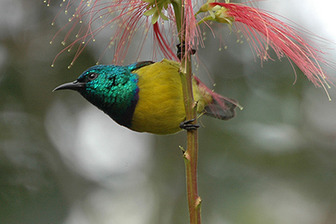Collared Sunbird
Sunbird flight is fast and direct on their short wings. Most species can take nectar by hovering like a hummingbird, but usually perch to feed most of the time.

Original source: Own work
Author: Tom TarrantPermission(Reusing this file)Attribution ShareAlike 3.0
The Collared Sunbird is classified as Least Concern. Does not qualify for a more at risk category. Widespread and abundant taxa are included in this category.
The Collared Sunbird, Hedydipna collaris (formerly placed in the genus Nectarinia), is a sunbird. The sunbirds are a group of very small Old World passerine birds which feed largely on nectar, although they will also take insects, especially when feeding young. Collared Sunbird is in fact mainly insectivorous. A male in a garden grapevine. Sunbird flight is fast and direct on their short wings. More
Collared Sunbird is a common breeder across most of sub-Saharan Africa. Two or three eggs are laid in a suspended nest in a tree. It is a seasonal migrant within its range. Collared Sunbirds are tiny, only 9-10 cm long. They have short thin down-curved bills and brush-tipped tubular tongues, both adaptations to nectar feeding. The adult male has glossy green upperparts and head with a yellow belly and narrow purple breast band. More
Distribution of Collared sunbird in southern Africa, based on statistical smoothing of the records from first SA Bird Atlas Project (© Animal Demography unit, University of Cape Town; smoothing by Birgit Erni and Francesca Little). Colours range from dark blue (most common) through to yellow (least common). See here for the latest distribution from the SABAP2. More
Collared Sunbird - Hedydipna collaris Souimanga à collier = Souimanga à collier Comment : Juillet 2008 Tropical Birds Coloring Book Gallery : © Didier Buysse Site web : Vision d'oiseaux Order : Passériformes Family : Nectariniidae Species : Collared Sunbird Sex : Male Age : Adult Reference: dibu61403 Other pictures Date taken : 2008 More
Chinspot Batis (Batis molitor) | Collared Sunbird Hedydipna collaris | Common Sandpiper (Actitis hypoleucos) | Cormorants, darters | Dark-capped bulbul (Pycnonotus tricolor) | Ducks & Geese | Flycatchers | Fork-tailed Drongo (Dicrurus adsimilis) | Francolins | Golden-Breasted Bunting (Emberiza flaviventris) | Golden-tailed woodpecker (Campethera abingoni) | Green-winged Macaw or Red-and-green Macaw (Ara chloroptera) | Green-winged Pytilia (Melba Finch)(Pytilia melba) | Helmeted Guineafowl (Numida meleagris) | Herons, Egrets & Hamerkop | Hoopoe (Upupa epops) | Hornbills | House Sparrow (Passer domesticus) | Ibises, More
is based on the Double Collared Sunbirds I saw at the Addo Elephant Park, South Africa * Evening light by Hillie Dijk This is another one of my whiteboard settings in-camera (making the photo black on white – see below). I saw Lori Peters’ Sunbird and thought I’d have a play. So I added the gradient fill. More
Collared Sunbird Comb Duck Comb-crested Jacana Common Black Hawk Common Bronzewing Common Bulbul Common Buzzard Common Crane Common Eider Common Fiscal Common Gallinule Common Grackle Common Ground Dove Common Guillemot Common Gull Common Hawk-cuckoo Common Merganser Common Myna Common Nighthawk Common Paraque Common Pochard Common Poorwill Common Quail Common Raven Common Redpoll Common Redshank Common Redstart Common Rosefinch Common Scoter Common Shelduck Common Snipe Common Starling Common Swift Common Teal Common Tern Common Tody-flycatcher Common Woodshrike Common Yellowthroat Condor Congo More
a picture of the Collared Sunbird on page 977. The Collared Sunbird belongs to the family of birds classified as Nectariniidae. According to the Percy FitzPatrick Institute of African Ornithology the Collared Sunbird is also known by these other names: Forest Sunbird. In the previous edition of Roberts (ie 6th edition) the Collared Sunbird was called the . The Robert's 7 Latin name for Collared Sunbird has changed from Anthreptes collaris in Robert's 6 to Hedydipna collaris. More

Original source: Alan Manson
Author: Alan Manson
Permission: Some rights reserved
Family : Nectariniidae
Genus : Anthreptes
Species : collaris
Authority : (Vieillot, 1819)
